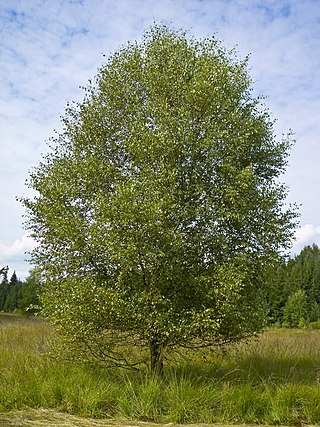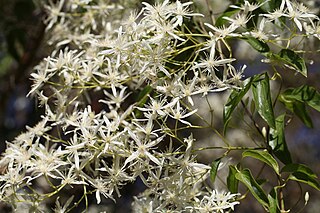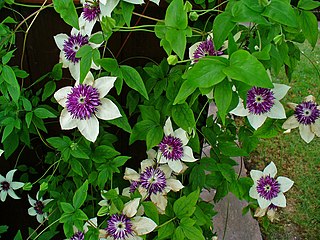
Clematis is a genus of about 380 species within the buttercup family, Ranunculaceae. Their garden hybrids and cultivars have been popular among gardeners, beginning with Clematis 'Jackmanii', a garden staple since 1862; more cultivars are being produced constantly. They are mainly of Chinese and Japanese origin.

Betula pubescens, commonly known as downy birch and also as moor birch, white birch, European white birch or hairy birch, is a species of deciduous tree, native and abundant throughout northern Europe and northern Asia, growing farther north than any other broadleaf tree. It is closely related to, and often confused with, the silver birch, but grows in wetter places with heavier soils and poorer drainage; smaller trees can also be confused with the dwarf birch.

The mountain papaya also known as mountain pawpaw, papayuelo, chamburo, or simply "papaya" is a species of the genus Vasconcellea, native to the Andes of northwestern South America from Colombia south to central Chile, typically growing at altitudes of 1,500–3,000 metres (4,900–9,800 ft).

Clematis vitalba is a shrub of the family Ranunculaceae.

Clematis microphylla is one of 8 Clematis species native to Australia. It occurs in all states and the ACT, but not in the Northern Territory.
Clematis is a town in Victoria, Australia, 42 km south-east from Melbourne's central business district, located within the Shire of Cardinia local government area. Clematis recorded a population of 352 at the 2021 census.
Discaria pubescens, the hairy anchor plant or Australian anchor plant, is a species of flowering plant in the family Rhamnaceae. It is native to Tasmania, Victoria, New South Wales and Queensland in Australia.

Clematis occidentalis is a species of flowering plant in the buttercup family known by the common name western blue virginsbower. It is native to much of southern Canada and the northern United States. There are three varieties: var. occidentalis is limited to the eastern half of the species' range, var. grosseserrata to the western half, and var. dissecta is endemic to Washington. The plant varies somewhat in appearance. Generally they produce vines and climb on surfaces. The leaves are divided into three thick, green leaflets, which may have lobes or teeth. The flower has no petals, but petallike sepals which are usually either deep purple-blue in western populations or reddish purple in eastern plants. White flowers are rare.
Western clematis is a common name for several plants and may refer to:

Clematis brachiata, commonly known as traveller's joy, is a hardy, deciduous Southern African liana of the family Ranunculaceae.

Clematis aristata, known as Australian clematis, wild clematis, goat's beard or old man's beard, is a climbing shrub of the family Ranunculaceae, found in eastern Australia in dry and wet forests of Queensland, New South Wales, Victoria and Tasmania. In spring to early summer it produces mass displays of attractive star-shaped flowers usually borne in short panicles with each flower up to 70 mm diameter and possessing four narrow white or cream tepals. Fertile male and female reproductive structures occur in flowers of separate plants (dioecy) making this species an obligate outcrosser with pollen movement among plants most likely facilitated by insects. Each seed head on female plants consists of multiple achenes with each seed bearing a plumose awn 2–4.5 cm long promoting dispersal by wind.
Calophoma clematidina is a fungal plant pathogen and the most common cause of the disease clematis wilt affecting large-flowered varieties of Clematis. Symptoms of infection include leaf spotting, wilting of leaves, stems or the whole plant and internal blackening of the stem, often at soil level. Infected plants growing in containers may also develop root rot.

Acacia pubescens, also known as the downy wattle, is a species of wattle found in the Sydney Basin in eastern New South Wales. The downy wattle is classified as vulnerable; much of its habitat has vanished with the growth of the city of Sydney. As with all wattles, it has compound (pinnate) leaf stems.

Clematis glycinoides, commonly known as headache vine, is a shrub or climber of the family Ranunculaceae, found in eastern Australia and New Caledonia.

Clematis crispa is a species of flowering plant in the buttercup family known by the common name swamp leatherflower. It is found in southeastern United States.

Clematis pitcheri is a species of flowering plant in the buttercup family known by the common name bluebill. It is a herbaceous, perennial vine found in the south-central United States and northern Mexico. It grows in wooded, rocky outcrops, woodland margins, bluffs, and disturbed habitats. Leaves are variable, oppositely arranged along the stems, and can be simple or compound. In the fall it will die back to ground level.

Clematis tangutica, the golden clematis, is a species of flowering plant in the family Ranunculaceae. It is found from Central Asia through to most of China, and it has been introduced to western Canada, Czechia, Slovakia, Switzerland, and the South Island of New Zealand. Its cultivars 'Bill MacKenzie' and 'Lambton Park', both members of the Tangutica Group, have gained the Royal Horticultural Society's Award of Garden Merit.

Clematis florida, the Asian virginsbower, or passion flower clematis, is a species of flowering plant in the family Ranunculaceae. It is native to southern China, and has been introduced to Korea and Japan. A perennial vine, in the wild it is typically found in shrublands and thickets, and alongside streams, at elevations around 1,700 m (5,600 ft). There are a number of cultivars commercially available, including 'Sieboldiana', Pistachio 'Evirida'PBR, and 'Plena'.














